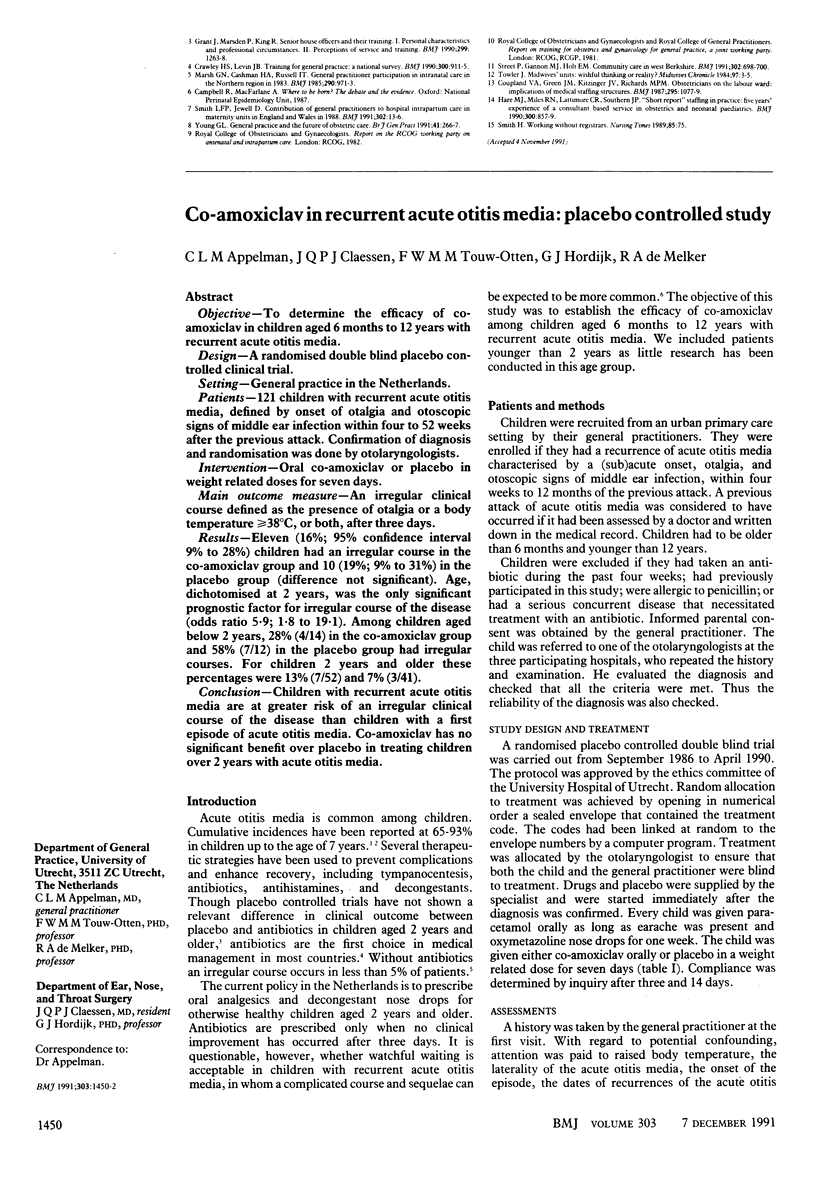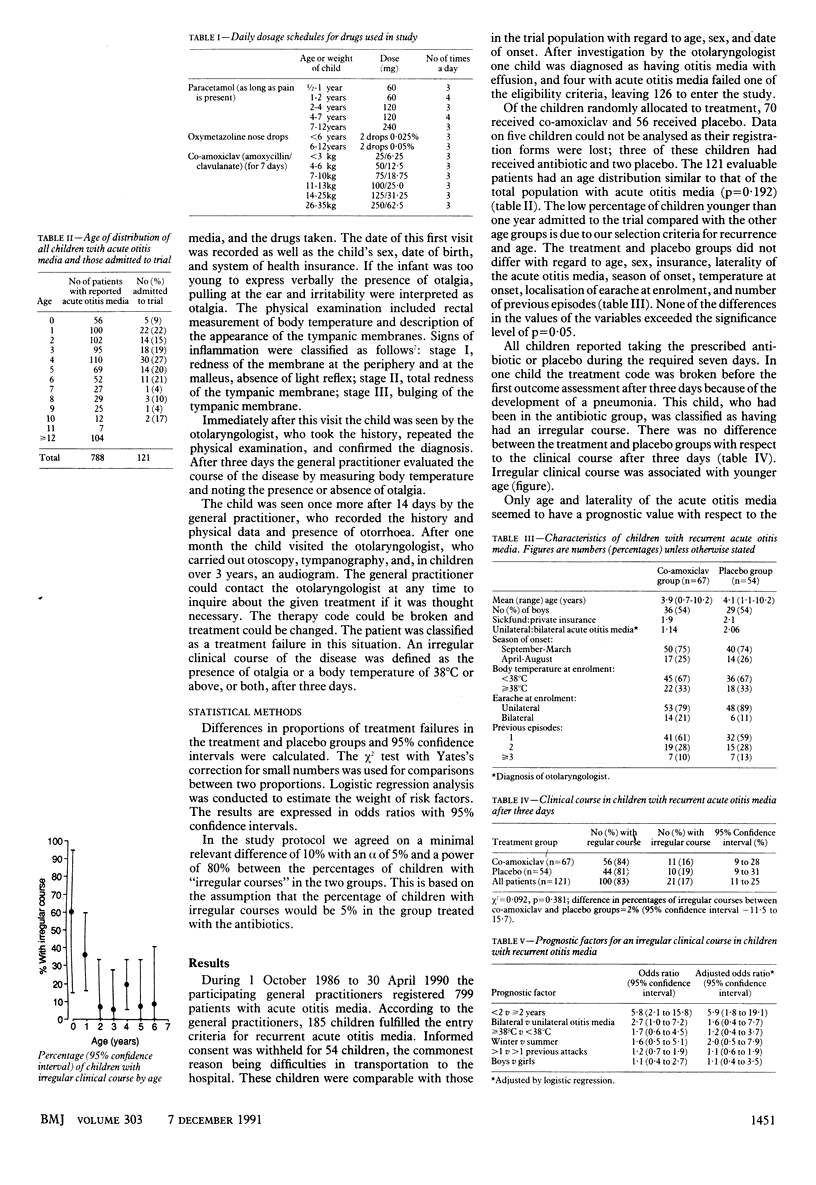Abstract
OBJECTIVE--To determine the efficacy of coamoxiclav in children aged 6 months to 12 years with recurrent acute otitis media. DESIGN--A randomised double blind placebo controlled clinical trial. SETTING--General practice in the Netherlands. PATIENTS--121 children with recurrent acute otitis media, defined by onset of otalgia and otoscopic signs of middle ear infection within four to 52 weeks after the previous attack. Confirmation of diagnosis and randomisation was done by otolaryngologists. INTERVENTION--Oral co-amoxiclav or placebo in weight related doses for seven days. MAIN OUTCOME MEASURE--An irregular clinical course defined as the presence of otalgia or a body temperature greater than or equal to 38 degrees C, or both, after three days. RESULTS--Eleven (16%; 95% confidence interval 9% to 28%) children had an irregular course in the co-amoxiclav group and 10 (19%; 9% to 31%) in the placebo group (difference not significant). Age, dichotomised at 2 years, was the only significant prognostic factor for irregular course of the disease (odds ratio 5.9; 1.8 to 19.1). Among children aged below 2 years, 28% (4/14) in the co-amoxiclav group and 58% (7/12) in the placebo group had irregular courses. For children 2 years and older these percentages were 13% (7/52) and 7% (3/41). CONCLUSION--Children with recurrent acute otitis media are at greater risk of an irregular clinical course of the disease than children with a first episode of acute otitis media. Co-amoxiclav has no significant benefit over placebo in treating children over 2 years with acute otitis media.
Full text
PDF


Selected References
These references are in PubMed. This may not be the complete list of references from this article.
- Engelhard D., Cohen D., Strauss N., Sacks T. G., Jorczak-Sarni L., Shapiro M. Randomised study of myringotomy, amoxycillin/clavulanate, or both for acute otitis media in infants. Lancet. 1989 Jul 15;2(8655):141–143. doi: 10.1016/s0140-6736(89)90192-x. [DOI] [PubMed] [Google Scholar]
- Feenstra L. Acute ontsteking van het middenoor. Ned Tijdschr Geneeskd. 1985 Mar 23;129(12):532–536. [PubMed] [Google Scholar]
- Froom J., Culpepper L., Grob P., Bartelds A., Bowers P., Bridges-Webb C., Grava-Gubins I., Green L., Lion J., Somaini B. Diagnosis and antibiotic treatment of acute otitis media: report from International Primary Care Network. BMJ. 1990 Mar 3;300(6724):582–586. doi: 10.1136/bmj.300.6724.582. [DOI] [PMC free article] [PubMed] [Google Scholar]
- Halsted C., Lepow M. L., Balassanian N., Emmerich J., Wolinsky E. Otitis media. Clinical observations, microbiology, and evaluation of therapy. Am J Dis Child. 1968 May;115(5):542–551. doi: 10.1001/archpedi.1968.02100010544003. [DOI] [PubMed] [Google Scholar]
- Howie V. M., Ploussard J. H. Efficacy of fixed combination antibiotics versus separate components in otitis media. Effectiveness of erythromycin estrolate, triple sulfonamide, ampicillin, erythromycin estolate- triple sulfonamide, and placebo in 280 patients with acute otitis media under two and one-half years of age. Clin Pediatr (Phila) 1972 Apr;11(4):205–214. doi: 10.1177/000992287201100407. [DOI] [PubMed] [Google Scholar]
- Howie V. M., Ploussard J. H., Sloyer J. The "otitis-prone" condition. Am J Dis Child. 1975 Jun;129(6):676–678. doi: 10.1001/archpedi.1975.02120430016006. [DOI] [PubMed] [Google Scholar]
- Ingvarsson L., Lundgren K. Penicillin treatment of acute otitis media in children. A study of the duration of treatment. Acta Otolaryngol. 1982 Sep-Oct;94(3-4):283–287. doi: 10.3109/00016488209128915. [DOI] [PubMed] [Google Scholar]
- Kaleida P. H., Bluestone C. D., Rockette H. E., Bass L. W., Wolfson J. H., Breck J. M., Ubinger E. B., Rohn D. D. Amoxicillin-clavulanate potassium compared with cefaclor for acute otitis media in infants and children. Pediatr Infect Dis J. 1987 Mar;6(3):265–271. doi: 10.1097/00006454-198703000-00013. [DOI] [PubMed] [Google Scholar]
- Lorentzen P., Haugsten P. Treatment of acute suppurative otitis media. J Laryngol Otol. 1977 Apr;91(4):331–340. doi: 10.1017/s0022215100083742. [DOI] [PubMed] [Google Scholar]
- Mygind N., Meistrup-Larsen K. I., Thomsen J., Thomsen V. F., Josefsson K., Sørensen H. Penicillin in acute otitis media: a double-blind placebo-controlled trial. Clin Otolaryngol Allied Sci. 1981 Feb;6(1):5–13. doi: 10.1111/j.1365-2273.1981.tb01781.x. [DOI] [PubMed] [Google Scholar]
- Stickler G. B., Rubenstein M. M., McBean J. B., Hedgecock L. D., Hugstad J. A., Griffing T. Treatment of acute otitis media in children. IV. A fourth clinical trial. Am J Dis Child. 1967 Aug;114(2):123–130. doi: 10.1001/archpedi.1967.02090230053002. [DOI] [PubMed] [Google Scholar]
- van Buchem F. L., Dunk J. H., van't Hof M. A. Therapy of acute otitis media: myringotomy, antibiotics, or neither? A double-blind study in children. Lancet. 1981 Oct 24;2(8252):883–887. doi: 10.1016/s0140-6736(81)91388-x. [DOI] [PubMed] [Google Scholar]
- van Buchem F. L., Peeters M. F., van 't Hof M. A. Acute otitis media: a new treatment strategy. Br Med J (Clin Res Ed) 1985 Apr 6;290(6474):1033–1037. doi: 10.1136/bmj.290.6474.1033. [DOI] [PMC free article] [PubMed] [Google Scholar]


